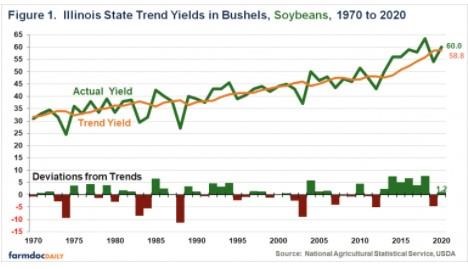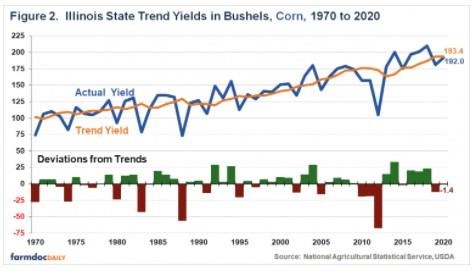The National Agricultural Statistical Service (NASS) — an agency of the U.S. Department of Agriculture — released their final estimates of state yields in January. Illinois’ state yield for soybeans in 2020 was 60 bushels per acre, 6 bushels per acre higher than the 2019 yield of 54 bushels per acre. The 2020 yield of 60 bushels per acre is the second-highest yield in history, only exceeded by a 63.5 bushels per acre yield in 2018 (see Figure 1).

Figure 1 shows actual soybean yields in Illinois, along with trend yields. A trend yield represents the expected yield for each year before the production year begins. The trend yield for 2020 was 58.8 bushels per acre. If 2020 could be repeated many times, the average of the repeated actual yields would equal 58.8 bushels per acre. The actual yield of 60 bushels per acre was 1.2 bushels per acre higher than the trend yield, indicating that 2020 was an above-trend year.
Trend yields shown in Figure 1 are based on linear regressions of the yields for the previous 20-years. The 1970 trend yield is based on actual yields from 1950 through 1969, the 1971 trend yield is based on actual yields from 1951 through 1970, and so on up to the 2020 trend yield, which is based on actual yields from 2000 to 2019.
Calculation of trend yields with the most recent 20-years’ data allows trend yields to represent the most recent information. Note that the trend yields for soybeans have increased more in years since 2014 than in years before 2014 (see Figure 1). From 1971 to 2013, trend yields from one year to the next increased an average of .4 bushels per acre. From 2014 to 2020, trend yields increased an average of 1.6 bushels per year.
Increasing trend yields in recent years reflect the exceptional yields that Illinois has had in most years since 2012. From 2013 through 2018, actual yields exceeded trend yields by an average of 5.6 bushels per acre. Due to late planting caused by a wet spring, the actual yield for 2019 of 54.0 bushels per acre was 4.5 bushels below the trend yield of 58.5 bushel per acre. The 2020 yield of 60.0 bushels per acre again exceeded the 58.8-bushel trend by 1.2 bushels per acre.
State Corn Yields in Illinois
The average state yield for corn in 2020 was 192 bushels per acre, 1.4 bushels below the trend yield of 193.4 bushels per acre (see Figure 2). Due to wet weather, the 2019 actual yield of 182 bushels per acre was also below trend, 12.6 bushels lower than the trend yield of 193.6 bushels per acre for the year.
In recent years, trend corn yields have been increasing, similar to soybeans. From 1971 to 2014, the average yearly increase in trend yields was 1.4 bushels per year. From 2014 to 2020, the average trend yield increased by 4.3 bushels per year.

Relatively High Recent Yields
Since the 2012 drought, both soybeans and corn have had a period of excellent yields in Illinois, leading to higher growth in trend yields than in years previous to 2012. This period of exceptional yields leads to questions of whether technological increases or good weather have been driving higher yields. Likely, both technology and weather have played a role. For soybeans, earlier planting of soybeans and corresponding use of seed treatments likely led to soybean yield increases. For both corn and soybeans, seed genetic companies’ increased use of information technologies in breeding probably has accelerated trends.
Still, good weather also plays a role. Illinois has not seen widespread drought since 2012, a positive for corn yields which can be particularly susceptible to dry weather. Instead, both July and August weather has generally been conducive to higher yields. If man-made climate change is currently affecting weather in Illinois, it has not resulted in below-trend yields or diminishing increases in trend yields. Despite much concern about climate change, the overall levels of recent yields in Illinois do not present alarm.
The large increases in trend yields may not continue into the future. That is dependent on the rate of development for new products or practices that can improve yields versus the plateau effect of those already in use. If early planting and seed treatments increased soybean yields more in recent years, the increase from the adoption of these technologies likely will come to an end when these practices have widespread adoption, a situation that may have occurred already. Moreover, pests in agriculture have been relatively controlled in recent years. Soybean aphids, corn borer, rootworms, and other pests have not presented widespread problems, but new pest issues could arise at any time.
Summary
In Illinois, soybean and corn yields have been exceptional since the 2012 drought. The period of good yields may come to an end. Still, it is reasonable to obtain the trend levels for 2021, which are 60.3 bushels per acre for soybeans and 195.9 bushels per acre for corn.
Source : illinois.edu